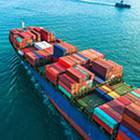
Freight rates are continuing to hold firm despite the current unprecedented collapse in global economic activity, not least in Europe and the U.S., the world’s major import markets.
The ‘composite index’ of the World Container index (WCI) assessed by Drewry has decreased just 0.8% in the last week and is still 11.2% higher than a year earlier.
Spot rates from Shanghai to New York declined 3% or $88 in the week ending 23 April to reach $2,608 per 40ft box (FEU), 2% lower than a year ago.
Rates from Shanghai to Los Angeles dwindled by $47 week-on-week to total $1,558 per FEU, while rates from Rotterdam to Shanghai inched down by 1% to stand at $969 per FEU.
However, freight rates on Shanghai to Genoa and Shanghai to Rotterdam nudged up 2% and 1% to touch $1,871 and $1,490 respectively.
Shanghai-Genoa spot rates are now 26% higher than a year ago while Shanghai rates are up 13% year-on-year.
Box imports into Europe are expected to peak in the next two weeks as the last orders placed before lockdowns commenced are delivered. Thereafter one liner source expects May and June “to be very slow; slower than we’ve seen before” putting freight rates under severe downward pressure.
Lines are, thus far at least, maintaining remarkable discipline as they seek to prevent a disastrous freight rates collapse, a point Alan Murphy, CEO of Sea-Intelligence, noted earlier this week.
“We are now at a point where 435 sailings are now cancelled on various deep-sea trades, and this in itself indicates a demand decline of 7 Million TEU in 2020,” he said.
“This forceful response to the market downturn has thus far served as a strong underpinning for freight rates.
“Seen over the past 6 weeks, the CCFI contract rate index is 11% higher than at the same period last year – despite the drop in both demand and oil prices.
“The decline in the overall index since Chinese New Year can be shown to be in line with normal seasonality.”
In the analyst’s latest Sunday Spotlight briefing Murphy also noted that the various container alliances were taking very different approaches to cutting capacity.
“The pattern is that 2M and THE Alliance have chosen an approach where they announce blank sailings ranging quite far into the future – typically to the end of Q2 – and then supplement these with a few additional blank sailings tactically as the situation evolves,” he said.
“Ocean Alliance on the other hand announced blank sailings for a shorter period into the future and have not yet announced much for the later period in Q2. As an example on the trans-Pacific, the three alliances have each blanked some 17-24% in weeks 15-21. However, for weeks 22-27, 2M and THE Alliance have blanked 19-21% whereas Ocean Alliance at this point has blanked only 6%.”
He noted: “Given how the pandemic is impacting the economy it should be expected that we will see more blank sailings emerge from Ocean Alliance in Q2.”
Source: lloydsloadinglist
Quality Companies